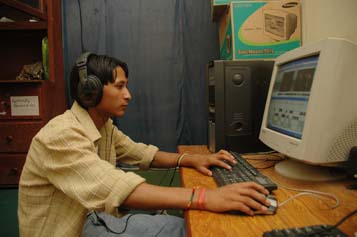I too have a story
06-06-2006 (Kathmandu)
Thanks to a recent training workshop held in Nepal on Digital Storytelling, the Tansen community media centre in the Palpa District of Western Nepal has a new segment in their local cable TV programme titled “I too have a story”.
The workshop, supported by UNESCO’s International Programme for Development of Communication, trained volunteers and staff from Nepal’s community multimedia centres to make their own digital stories and prepared them to start training others.
Digital stories are short, personal multimedia pieces that community members can create themselves using computers and other digital equipment like still and video cameras, scanners and audio recorders.
"We will have at least two digital stories telecast every week through our local cable channel. The digital story telling format is also a tool that can be used to generate revenue in exchange for creating stories of individuals and organisations," says Mahesh Ratna Shakya, coordinator of Tansen CMC.
In a six-day, hands-on workshop, nine volunteers, including four women, wrote scripts, recorded audio track and mixed images to create short 2-3 minute digital stories with the support of trainers. Some of the participants, like Birendra Sunar, used the format to tell deeply personal stories. Birendra, from the Lumbini CMC in nearby Rupandehi District in the southern plains, narrated his experience of caste discrimination and how this practice still exists even amongst the educated youths. Caste discrimination and untouchability amongst traditionally marginalised communities in Nepal is a predominant social issue identified through ethnographic action research, an integrated evaluation tool used by all the CMCs.
All nine participants of the workshop plan to go back and train community members and volunteers at their respective CMCs to make their own stories about community issues and create awareness amongst the local community people. "Four participants rewrote their story, re-selected the images and re-recorded the audio and made the video, all in just one day!!! And that was amazing - I didn't know that they created a new version till I saw the new ones in the TV,” said Pawan Prakash Upreti, lead trainer, clearly surprised by not only the skills level of the new trainees, but also their commitment to ensuring that their stories were the best they could be.
The workshop also gave participants from other CMCs in Nepal, Madanpokhara and Lumbini, the opportunity to observe activities at the Tansen CMC, which uses a unique combination of local cable TV and digital tools, from cameras to computers.
The Tansen CMC’s cable channel reaches over 2500 households in Tansen town and its neighbouring villages. Twice a week, volunteers and youth involved with Tansen CMC produce a two hour programme that addressing local community needs and issues, and it has a new segment called ‘I too have a story’.
To view the digital story made by Birendra Sunar, click here.
Story contributed by Karma Tshering, Nepal CMC coordinator.
Digital stories are short, personal multimedia pieces that community members can create themselves using computers and other digital equipment like still and video cameras, scanners and audio recorders.
"We will have at least two digital stories telecast every week through our local cable channel. The digital story telling format is also a tool that can be used to generate revenue in exchange for creating stories of individuals and organisations," says Mahesh Ratna Shakya, coordinator of Tansen CMC.
In a six-day, hands-on workshop, nine volunteers, including four women, wrote scripts, recorded audio track and mixed images to create short 2-3 minute digital stories with the support of trainers. Some of the participants, like Birendra Sunar, used the format to tell deeply personal stories. Birendra, from the Lumbini CMC in nearby Rupandehi District in the southern plains, narrated his experience of caste discrimination and how this practice still exists even amongst the educated youths. Caste discrimination and untouchability amongst traditionally marginalised communities in Nepal is a predominant social issue identified through ethnographic action research, an integrated evaluation tool used by all the CMCs.
All nine participants of the workshop plan to go back and train community members and volunteers at their respective CMCs to make their own stories about community issues and create awareness amongst the local community people. "Four participants rewrote their story, re-selected the images and re-recorded the audio and made the video, all in just one day!!! And that was amazing - I didn't know that they created a new version till I saw the new ones in the TV,” said Pawan Prakash Upreti, lead trainer, clearly surprised by not only the skills level of the new trainees, but also their commitment to ensuring that their stories were the best they could be.
The workshop also gave participants from other CMCs in Nepal, Madanpokhara and Lumbini, the opportunity to observe activities at the Tansen CMC, which uses a unique combination of local cable TV and digital tools, from cameras to computers.
The Tansen CMC’s cable channel reaches over 2500 households in Tansen town and its neighbouring villages. Twice a week, volunteers and youth involved with Tansen CMC produce a two hour programme that addressing local community needs and issues, and it has a new segment called ‘I too have a story’.
To view the digital story made by Birendra Sunar, click here.
Story contributed by Karma Tshering, Nepal CMC coordinator.
 Digital editing at Tansen CMC
Digital editing at Tansen CMC© UNESCO Office New Delhi
Related themes/countries
· Nepal
· Information for Community Development
· 2006
· Content Development: News Archives 2006
Share this story:
Contact information
- UNESCO
Source
- UNESCO Office in Kathmandu
- UNESCO Office New Delhi
Field office














